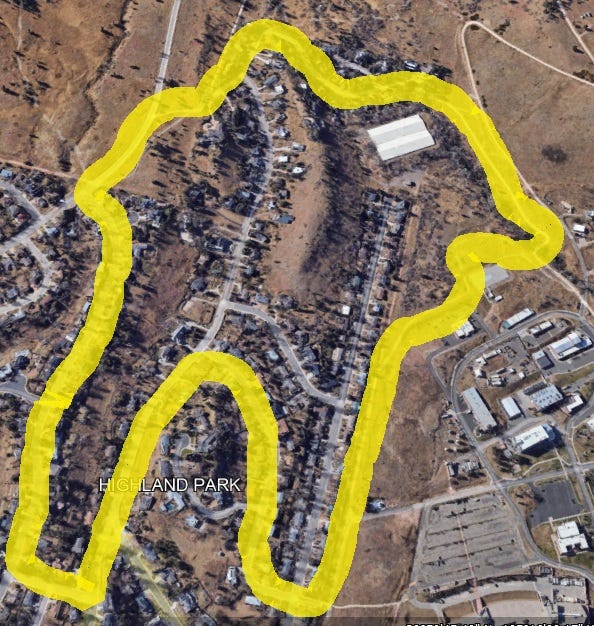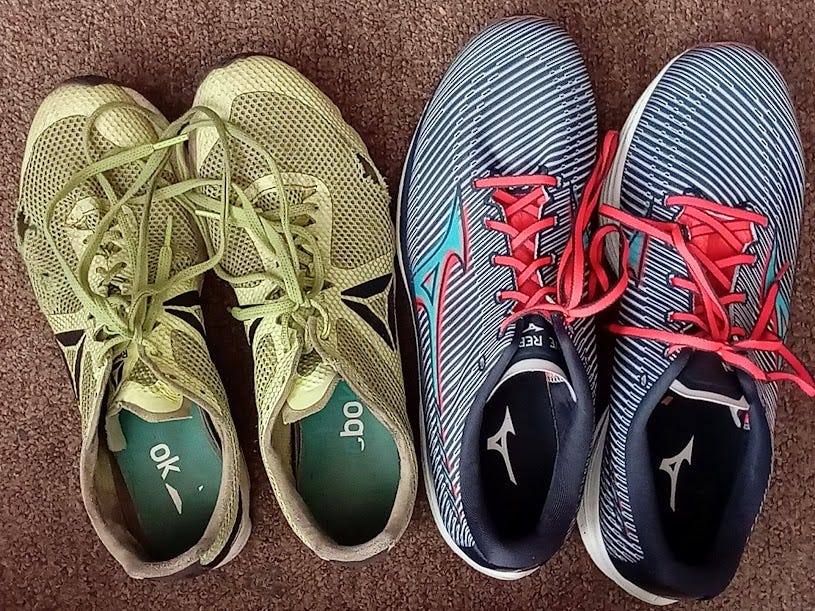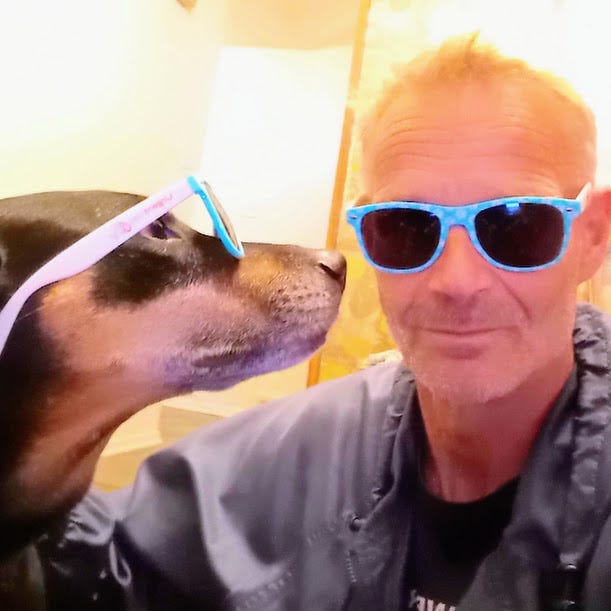Chasing coyotes is best done in a trancelike state and while flirting with the commission of federal crimes
Also, Mike Trout is just itching for me to sue him
I’ve been spending about four days a week in the southwestern part Boulder, Colorado, the first part of the city I got to know well after making my first expedition here in June 2009. After moving to the eastern part of town in 2017, I haven’t spent nearly as much time over here among Southerners as I should have. I’m glad that’s changing.
Part of this aversion has rested in a conscious avoidance of the hilly roads and especially the trails in and around the Highland Park neighborhood, the National Center for Atmospheric Research (NCAR), and the National Institute of Standards and Testing (NIST(. The main rationale is keeping my right knee free of excessive stress—actually, both knees, and for that matter both elbows, but I tend to focus primarily on known trouble-spots. The secondary reason is the absence of flowing or standing water at higher elevations; I don’t typically swim in or drink from creeks or ponds while running, but the near=daily training partner I’ve had for the past five and a half years veritably relies on these gravity-dependent aid-stations even when it’s 50 degrees American (and today it got up to 65).
In just the fourteen years since I first set foot in Boulder, the Highland Park neighborhood has changed drastically, and in fact its ongoing transformation may not yet have reached its zenith. But my oldest friend is 98 years old and has lived in the same house in this neighborhood since 1963, when she and her husband, a physics professor down the hill and to the north at the University of Colorado, moved into the only house on what was then a dirt road. The sign outside, she says, read not “Open House” but “Come In for Admiration.” At the time, most locals felt that this neighborhood had little potential for residential growth owing to the winds, which are markedly more severe in Highland Park than they are a few hundred vertical feet lower downtown and at points east. You’ll soon see how accurate that dour consensus was.
The new couple was not entirely alone in their new digs. Less than half a mile west and up the hill, just before the road met Table Mesa Drive, sat a small cluster of houses. Just uphill and to the west of these, accessible from what was then a private driveway, was a behemoth of a newly built mansion slung up against the invisible rough edge of the “Blue Line,” which had been established in 1959. In the mid-1960s, Table Mesa Drive was extended westward from Gillapsie Drive to what had been the dead end of Vassar Drive, and from this junction rose the new the C-shaped dead-end road up to NCAR, which had been approved as a project in 1961 and built beginning in 1964. The set of structures collectively known as the Mesa Laboratory, designed by I.M. Pei, commenced operations in 1967.
The behemoth-house had been built for an heiress to the Samsonite fortune, a woman who reportedly boasted the typical baggage of a lifelong wealthy woman of the day whose job was to marry someone respectable. Back then, college professors were widely judged to be respectable, and the heiress had married one of these, a man familiar with Janine’s husband. At one point, Professor Carter invited Janine and her husband to the behemoth-house for dinner. They accepted, and when they arrived, it was just them, the heiress, and a smattering of servants.
When one of these servants brought a silver platter with prime cuts of meat to the dinner table, the heiress allegedly picked up her silverware and began enthusiastically cutting up the meat while also making visible caverns in the platter itself. “Are you sure you want to do that, Faye?” Janine’s husband asked, probably with more curiosity than alarm. The response—delivered without a pause in carving-action or an upward glance from the dying platter—was “This is what I always do.”
At some point, this woman, who may well have inspired the creation of the animated character Cruella de Vil, also had a smattering of Quonset huts built in her back yard, which was to the east of the behemoth and looked down onto Kohler Drive, from which the private drive to the behemoth arose. This street was just beginning to fill up with homes owned by folks who were not precisely poor themselves. They didn’t like what they saw when looking about 20 degrees up and to the west, and they complained loudly and often to other residents, the city, and the newspaper. I don’t think this had much salutary effect, but eventually the ownership of property changed hands and whoever moved in immediately demolished the huts.
Janine’s house was situated where it lies and presented as the first home for sale in the immediate vicinity because the shape of the street it’s on assures that the yard behind the house is the only one on the road guaranteed to forever offer an unobstructed view of the Flatirons, the iconic set of rocks that by themselves have essentially doubled Boulder property values compared to the rest of the country; real estate is not my area of expertise, but it costs here are far out of proportion to the sizes of the building lots as well as—in most cases, anyway—the structural quality of the homes.
The view of the Flatirons from Janine’s house is to the west, but the L-shaped house offers a view to the north, too. Kohler Drive is visible toward the bottom of the photo below, while the C.U. Williams Village dormitories at center-far right are especially prominent because state=owned buildings don’t have to conform to the city-wide 55’ building-height limit.
As for whether the winds in this neighborhood were sufficient to prevent the acreage from achieving desirability, this is a snapshot from Zillow. The behemoth was rebuilt in 1997 and occupies an astonishing-to-me 84,000 square feet. And according to city records, Zillow is lowballing the value by close to three million clams.
Being outside around here is like wandering within a community where every permanent resident is required to have appeared in at least one Lands’ End or L.L. Bean photo shoot. I saw a Japanese-American woman (or maybe just Japanese; there goes my racism again) walking a huge white dog, and she was so pretty I almost fainted. Now try figuring out which creature I mean.
My favorite run in this area is an awesome-for-dogs loop that includes maybe three and a half miles of climbing and descending on pavement, wide gravel lames, rutty single-track trails, and public paths and marked bike-routes wending their way through NIST, which part of the U.S. Department of Commerce.
NIST was in fact the first Boulder-associated thing I remember learning about. When I was in elementary school in the late 1970s, I read something about the most precise clock in the world being housed at the facility, then widely known (and still known to Janine) as the Bureau of Weights and Measures. This is still the case; scientists have figured out how to use microwave radiation to manipulate the quantum states of the electrons of cesium atoms so that this timekeeper loses or gains less than one second every 90 billion years, almost seven times as long as the estimated age of the cosmos itself.
Until today, I did not realize that my favorite Highland Park loop resembles either an extracted human bicuspid tooth or a sloppy line drawn around a human murder victim.
That gray square buried within the “murder victim’s” left deltoid muscle (assuming a face-up corpse) is a water tank. The other day, I was traversing the single-track path along the “shoulder” itself when I noticed that Rosie had picked up the pace perhaps a minute earlier. Whenever I run with Rosie, even on streets or wide paths, I tend to focus my eyes most strongly on the ten or fifteen feet in front of me. On narrow trails, this is even more pronounced and I am usually looking at little besides what I can see of the ground that will be greeting my next several steps (most of this is obscured by dog).
This is how I managed to avoid noticing the reason Rosie had sped up until around 200 meters into her “surge”: A coyote was loping along about 100 feet ahead of us, not merely looking back over its shoulder but running with its head turned severely backward, almost like an owl. When I noticed the animal, my first thought was, “I’m surprised it doesn’t smash into a tree jogging along blind like that.” My second was that, although the few coyotes I’ve seen around here are skittish and apt to run away, actually pursuing one with a canine in tow is probably not the smartest idea. Especially while generally moving away from civilization rather than toward it. So I stopped and waited about thirty seconds, watching the triangular head disappear into the woods while still warily regarding us.
Shortly before this encounter, I had deviated slightly off course so that I could drop a bag of Rosiecrap into a trash bin. But when I was about to do so, I saw the sign on the dumpster that read FOR USE OF U.S. DEPT OR COMMERCE or whatever, and realized that putting the dog crap in this dedicated trash bin would be committing a federal crime. That was close. I wonder whatever became of that bag. Were I a member of the Proud Boys, at least one of the few of its members not working for the feds, the feds would be scanning this site and preparing to send federal marshals to my home tomorrow to apprehend me on suspicion of vandalizing federal property or some such. And were I Donald Trump or a close associate, I’d already be indicted on eighteen counts of felony menacing (or some such).
I would never dare break any federal or even municipal laws, but I’m more willing to take chances with hills all of a sudden because I recently purchased a new pair of trainers. Whether in a competitive mode or not, I have traditionally done most of my running in very lightweight trainers or racing flats. Since whatever cushioning these start out with is gone within three weeks anyway, I just keep using shoes until both the mesh of the upper and the shoelace eyelets are all but gone.
Although I don’t typically notice a tremendous difference between ancient and brand-new shoes, anyone who goes as many steps as I do between new pairs can’t help but feel a healthy boost in springiness with the fresh ones strapped on. I also plan to avail myself of a genuine racing shoe this weekend, although it’s unclear at present exactly how I plan to torment myself with these.
Speaking of willful self-torment, someone sent me some examples of what Latoya Snell’s commenters wrote in response to her summary of my latest articles including her name, which as usual didn’t include links to my work so that the yutzes who for whatever reason follow this woman could check the accuracy of this summary for themselves.
The exchange below is telling. Bear in mind that, whatever Snell’s chronically misdirected followers actually know or believe, Snell herself knows I’m not lying. So her seizing on someone unleashing a flood of boilerplate, scattershot nonsense shows how wounded she actually is when her lies are exposed, especially by someone whose life she has no means of disrupting. That is, she can’t do to me what she did to Nate Imhoff—and anyone who was watching that mess understood exactly what happened.
Even while knowing she was typing high-octane bunk—lying to her followers, lying to herself, lying to people like me who just use this material to further ridicule her—Snell still had to type it. And she’s not just trying to snooker her followers; it’s evident my articles have started to scratch away at whatever remaining strips of conscience she has. Snell is angry, and she wants to be angry entirely at me, but it’s not working that way. I’m seeing signs of real progress in this client.
And for his part, the commenter using the name Mike Trout, who is actually a Major League Baseball player who would have amazing stats for his age were he not hurt half the time, is drawing an awful lot of conclusions about someone whose articles he hasn’t even read. As much fun as he’s claiming to have here, you have to wonder about the private life of someone who follows Latoya Snell and writes things like these under a fake name. They’re not vicious, just strange.
I can obviously see how someone with a chronic weight problem would be pissed off even by the real versions of my posts, but I would guess that “Mike Trout” is the type whose sexual preferences trend toward XXXL women. There’s nothing wrong with this, and in fact it makes more and more sense to prefer heavier partners in a country where the average weight has been inexorably rising for decades. So I see “Mike” ultimately working his way toward self-acceptance, too, as long as he lives to be 200.
The first few times I ever read Internet threads about myself, it was somewhat disconcerting whether or not the content was mostly true and indeed whether or not it was mostly complimentary. But that was over 20 years ago, and after you’ve been through a serious wringer with a persistent and genuinely disturbed online stalker, that stuff no longer matters.
But none of that even applies here, because these comments and others in the tread aren’t even about me. They’re about a tiny, caricatured slice of the writing I do. And if Snell had a real answer to my articles, this just wouldn’t be the case and she’d dismantle my claims line by line just as I do with her and other deviants.
I have been bugging Janine for as much local lore as I can, because the combination of my curiosity about the history of local development (and related developments) and her affinity for recounting stories from her earliest days in a much smaller version of Boulder makes for a lot of cool chatting. I’ll be issuing more posts along these lines in the weeks to come.
[Note: This post was updated on 12/22/2023 to include the correct dates of NCAR’s completion and opening.]








